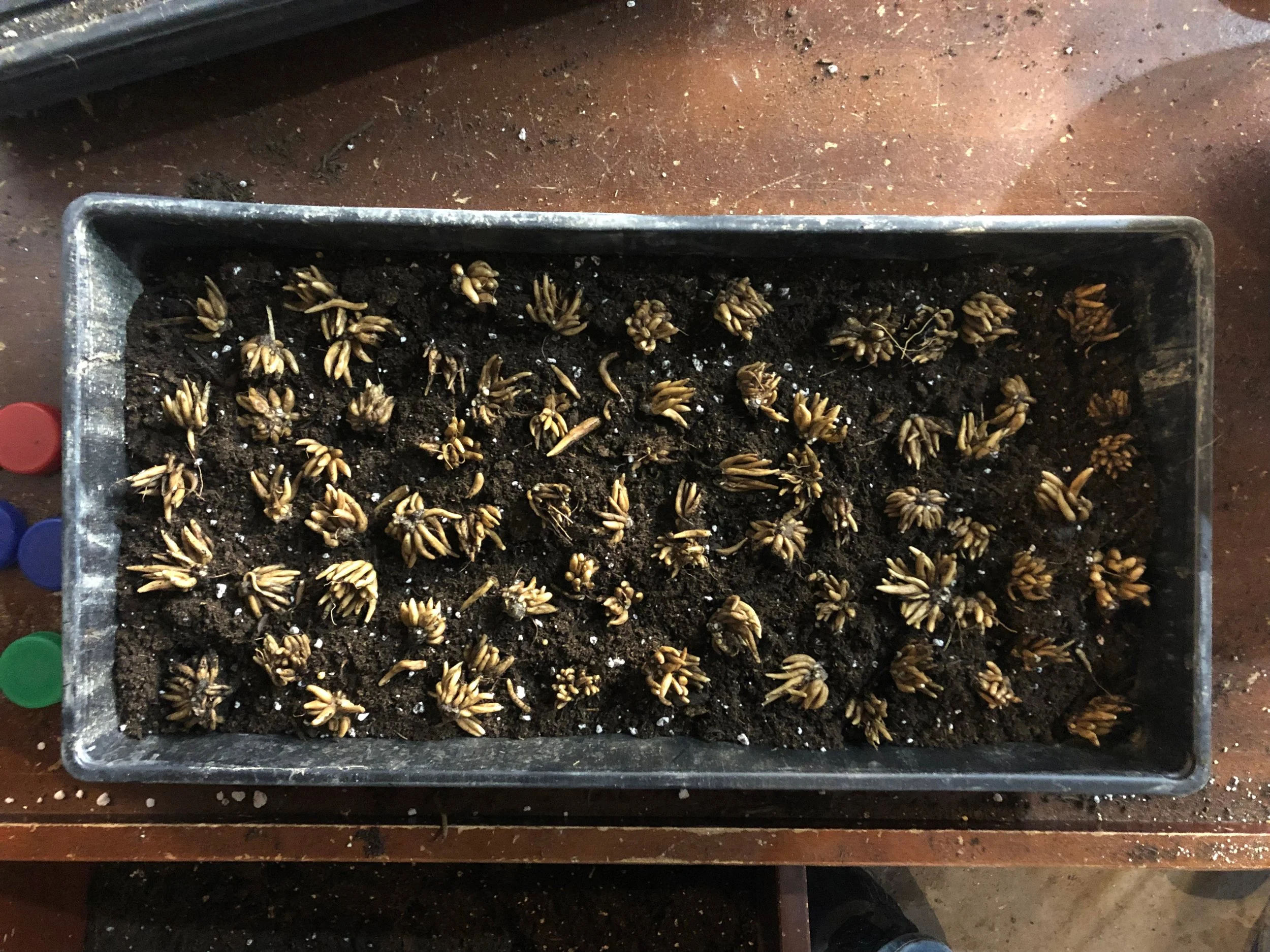How to Grow Ranunculus
We are often bewildered with how to grow ranunculus. But once you understand their preferred conditions and what temperatures they can tolerate, it’s simpler than what you might think!
Hardiness: Ranunculus are hardy to zone 7. Your zone will determine whether to plant in the fall to overwinter or late winter. Here in zone 6a, I utilize the protection of our hoop house to plant a large crop in the fall. I plant a second succession directly outdoors in early spring. By splitting the planting, I can extend the bloom time.
Appearance: If you have never seen a ranunculus corm, don’t be alarmed when you receive a bag of shriveled up baby octopi. They are very funky looking. It's hard to believe something so ugly can produce something so gorgeous.
Size: When growing ranunculus, it's important to start with quality corms and go big! The larger the corm, the more stored energy it has. The corm size will predict the number of flowers the plant will produce. The more stored energy, the healthier the plant resulting in more blooms. So when it comes to ranunculus, size matters.
If you are growing for cut flower production, opt for the largest size available which will yield the most stems.
Conditions: Ranunculus thrive in well-draining soil, full sun and the cooler temps of spring. Once temps start to warm, they will fade away into dormacy. Because they prefer the cool temps of spring, it isn’t recommended to grow ranunculus in landscape fabric. The fabric can warm the corms signaling dormancy before it’s time. On the upside, because they bloom in early summer, they generally outgrow the weeds because they have a head start.
When to Order: If you are ordering from a wholesaler, you always order for the following season when they are currently blooming. For example, if they bloom in May, you would order your corms for next season during May of the current season.
Generally, corms will ship in the fall. If you are waiting to plant until the spring, tuck your corms away in a cool, dry location such as a basement for the winter. Shop corms here.
When to Plant Ranunculus
Is this not THE question when it comes to ranunculus? Do you plant In the fall or do you plant in the spring? Timing is everything with ranunculus. You want to get them out there to flourish in the cooler temps of spring but don’t want them out too early because they can’t handle temperatures that are too cold (insert eyeroll).
I have found that in USDA zones 6b and below, ranunculus need protection to survive the harsh winters. Yes, we may have a mild winter and get lucky but generally, if you are zone 6b or below, wait until late winter to start unless you have protection nearby.
Protection can consist of a hoop house, greenhouse or low tunnel. When you have protection, aim to get them in the ground in the fall. The goal is to give the ranunculus adequate time to build a robust root system before winter arrives.
If you are starting ranunculus indoors to transplant in the spring, you will need to calculate your start date. Ranunculus can bloom for 4-6 weeks with optimum conditions, optimum conditions being the cool temps of spring. Once the 70- and 80-degree days arrive, your ranunculus will go dormant. So in order to give them a solid month of bloom time, count back 4 months from when these warm days arrive.
After transplanting outdoors, be sure to have frost cloth nearby. Every year, at least once, we have a cold snap and the ranunculus babies need to be protected.
How to Start Ranunculus
To wake your corms from dormancy, soak them in room temperature water for 3-4 hours. During that time, the corms will absorb water and quickly double in size.
They say to leave the water running (just barely) to provide additional oxygen in the water. This air flow helps to create an uninviting environment for bacteria. While this sounds good in theory, I find it silly! I’ve never used a fish tank air bubbler or left the water running.
If you are like me and try to multi-task, set the timer! Do not forget about your soaking corms because they will rot!
Pre-sprouting: Let me preface this section with…I don’t usually do this. I’ve never found the point of planting corms in one patch of dirt simply to transfer them to another patch of dirt. I’ve done it both ways but have yet to find a difference. Once again, it sounds silly to me but I will walk you through it so you can experiment with both options.
Once the corms have soaked, it's time to pre-sprout. To pre-sprout corms, fill a seed tray with an inch of moistened soil creating a bed for the corms. Then place the soaked corms on the soil and cover with another inch or so of soil. Place the trays in a cool dark location for 10-14 days. During the 10-14 day period, the corms will continue to swell and start to grow roots.
Ensure no rodents or cats can get to your trays. One season, my cat thought I gave him 12 new litter boxes!
Planting: Once they have pre-sprouted, they are ready to be planted outdoors or potted up which will depend on your zone. For those I plant in the spring, I will plant them in 50-cell trays to continue their growth indoors until the weather warms. I generally keep our late winter planted ranunculus under lights for 4-6 weeks.
Once they are ready to go outdoors be sure to harden them off. Hardening off is essentially a way to ease the plants from the warm comfy environment indoors to the elements outside.
Plant the corms 2" deep and 6" apart with the claws pointing down. It's best to have frost cloth or plastic nearby in case winter decides to return.
Ranunculus generally bloom in 90 days. Those planted in the spring will bloom for 4-6 weeks and those planted in the fall will bloom for 6 weeks or more.
When to Harvest Ranunculus
Harvest ranunculus when the buds are colored but prior to the petals unfurling. When you give them a gentle squish they will feel like a marshmallow. Harvested at this time will result in an incredible vase life of 10-14 days.
Ready for more?
Want to grow more than just ranunculus? If you’re loving this article, you’ll love my free resource—a step-by-step guide to growing the 10 most popular cut flowers for your garden or flower business. From planting to harvesting, this guide will help you grow healthy, beautiful blooms with confidence. Grab your free copy here!







